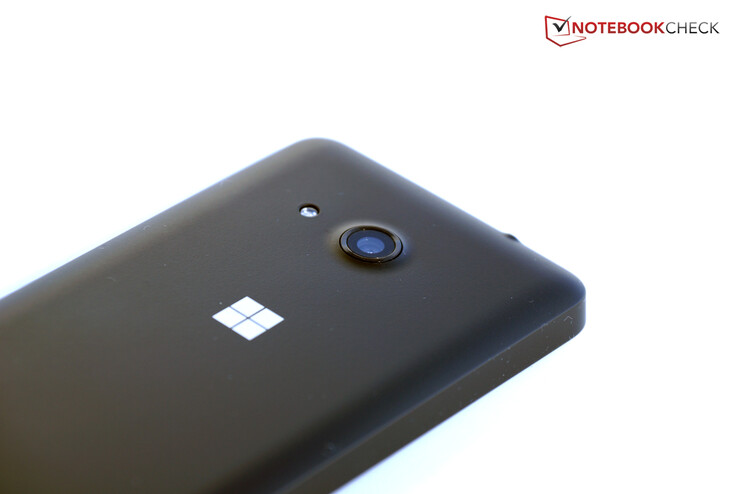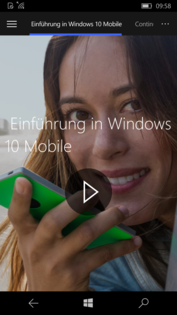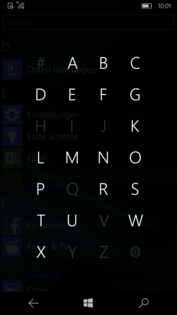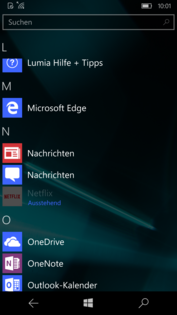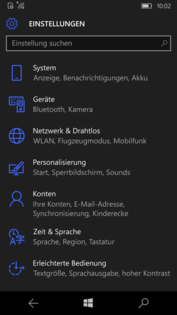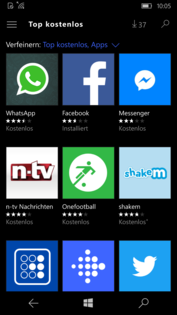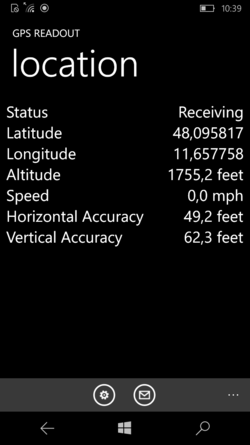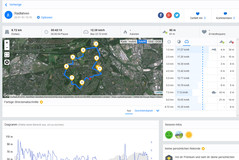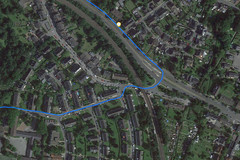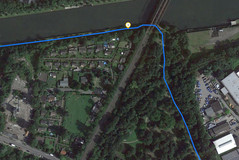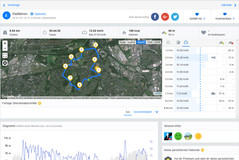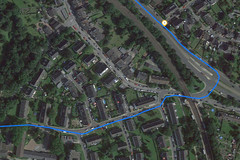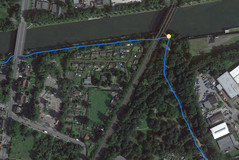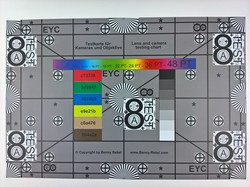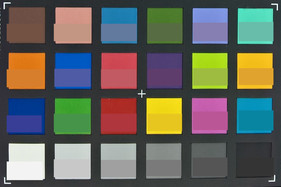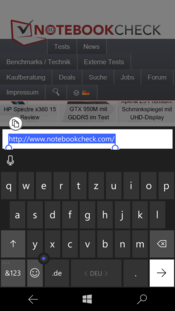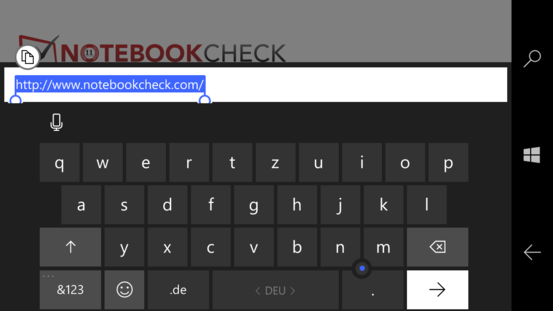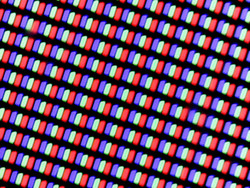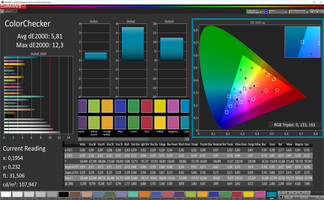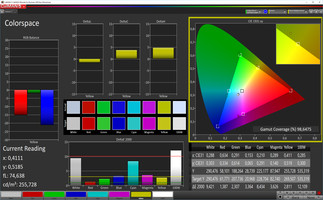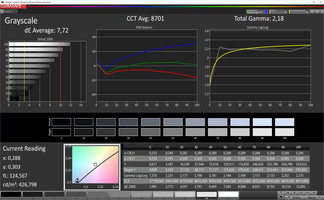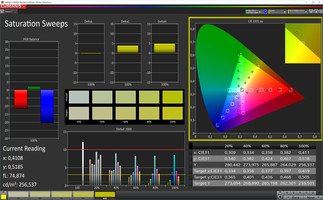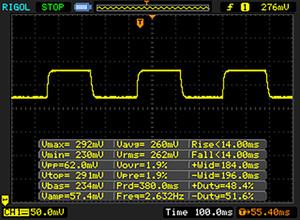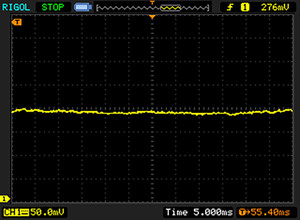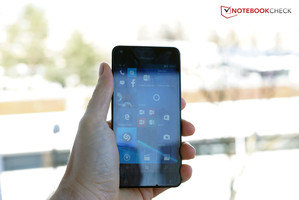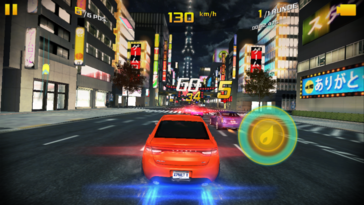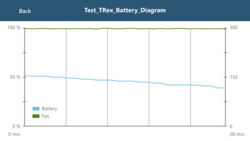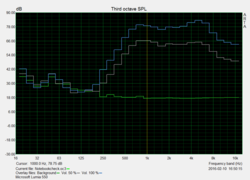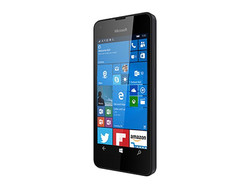Microsoft Lumia 550 Smartphone Review
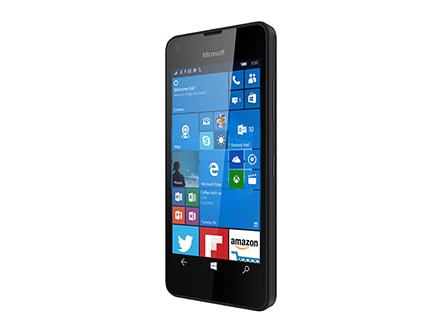
For the original German review, see here.
Microsoft's mobile operating system is not really getting anywhere. It still runs best in the low-cost sector. That is also where Microsoft's Lumia 550 is positioned. At a recommended price of 139 Euros (~$152), the device can be found for just 91 Euros (~$99) online. What does the buyer get? Features like a removable battery, LTE support, a casing made of solid plastic and a screen with a resolution of 1280x720 pixels.
The naming policy of Microsoft's smartphone is not easy to understand. However, the Lumia 550 might be seen as the successor of the Lumia 530 or Lumia 535 that we tested a year ago. Rivals are currently only found among Android devices, such as Sony's Xperia E4g, Samsung's Galaxy J1 and LG's Joy.
Case
The Lumia 550 inherits the design language of most Lumias with rounded corners and a main body that is inserted into a rear-sided plastic tray. In contrast to the Lumia 535, the shape is now a bit more angular giving the design a somewhat more serious look. The fact that the colors have been limited to only black and white also contributes to that. Other colors now seem to be out of fashion even for the low-cost Lumias.
The screen with a diagonal of 4.7-inches in the Lumia 550 is somewhat smaller than that of the predecessor. The dimensions have also been reduced: The Lumia 550 is shorter than and not as wide as the Lumia 535. On the other hand, its height of 9.9 millimeters bulges more visibly in the pocket.
The smartphone's front part fits firmly into the back cover. However, it can be dented clearly; pressure on both the front and rear quickly becomes visible on the screen. The Lumia 550 can also be twisted and also leads to image distortions. In view of the low price, the casing is throughout acceptable, but the buyer should not expect too much.
Connectivity
In the end, the connectivity of the Lumia 550 is comparable with that of the Lumia 535. However, some significant differences are found after all. The Lumia 550 supports LTE speeds, which was not possible in the predecessor. In return, the Lumia 500's front-facing camera has a lower resolution, but the screen's resolution is higher.
8 GB of flash memory and a micro-SD card slot are again incorporated as is a USB 2.0 port. NFC is not present.
Software
Users were not pleased about the first version of Windows 10: The Internet is full of reports about crashes, low performance and difficulties with apps. In fact, the Windows 10 Mobile version preloaded on our Microsoft Lumia 550 is not particularly stable. However, Microsoft already offers an update to fix many bugs, and we quickly installed it. The system runs more stably and faster - but not error-free.
Microsoft has set itself the goal of bringing the mobile operating system and the desktop version of Windows closer. Therefore, both versions are based on the same software core. That is to make it possible for applications to run on smartphones and desktops at the same time, which is very interesting for business customers. Besides that, a Windows 10 smartphone can be turned into a mini PC with a Bluetooth keyboard and wireless screen via the so-called "Continuum" feature. However, Lumia 550 owners will not be able to use that; the handset simply lacks the hardware requirements.
Our review sample's biggest similarities to Windows 10 on a PC are primarily the personal assistant "Cortana" and the new settings menu that, like in Windows 10 desktop, is divided into categories and makes it considerably clearer. Besides that, searching for something in the menu is convenient. There are also multiple improvements in details in contrast to Windows Phone 8.1. However, the differences are not really significant on low-cost devices since "Continuum" is not supported.
Microsoft preloads its Office apps that allow editing Office documents seamlessly on the go. Otherwise, a lot of bloatware and adware, such as Amazon or Netflix, are also preloaded.
Communication & GPS
As said, Microsoft installs a wireless module that also provides LTE Cat. 4 networks. 5 frequency bands are supported and maximum speeds of 150 MBit/s in downstream and 50 MBit/s in upstream are possible. We had a decent network quality in an urban area with the rather moderately developed German O2 E-Plus network in a short test. We usually had a signal strength of at least 3 bars even indoors.
The Lumia 550 connects to Wi-Fi via the 802.11 b/g/n standards. That is easily enough for fast browsing. However, techies will soon miss the high-speed 802.11 ac standard. The reception is decent. We still had a signal strength of 3/4 at a distance of 10 meters to the Wi-Fi router (FritzBox 6490) and through three walls. Pages opened noticeably slower than when near the router.
The GPS module installed in the Lumia could even track us reliably indoors. We achieved an accuracy of approximately 13 meters outdoors via the "GPS Test" (does not correspond to the same-named Android app). We take the Lumia 550 along with the Garmin Edge 500 navigation system on a mountain bike tour for more precise data. Using the "Runtastic" app, we compare the devices with each other. The Lumia 550 measures roughly 200 meters more and the recorded speeds are also clearly different. The devices' altimeters do not agree with each other, either.
Both devices are accurate enough at the railway crossing and the trip through a residential area afterwards. However, the Garmin Edge 500 tracks the route a bit more precisely. The route that the Lumia 550 recorded on the riverside trip is far off the actual path, while the Garmin Edge 500 positions us quite accurately. The Lumia 550 should be sufficient for occasional navigating, but users shouldn't rely on it completely.
Telephone & Call Quality
Microsoft reworked the phone app and adapted it with the new looks of Windows 10 Mobile. Tabs with "Log", "Quick Dial" and "Keypad" are found in the upper area. We miss the direct search box of Android's phone app where a name can be entered particularly in the beginning. Here, the user first has to switch to the contact app in Window's phone app. Although a name can be entered via the keypad's number buttons, it is not as intuitive. Not tragic, but it is a minor inconvenience.
The sound via the earpiece is relatively clear, but it sometimes hums and is very treble-heavy. Our contact also finds the microphone very clear. Microsoft can be praised for its choice of components here.
Cameras & Multimedia
The Lumia 535 still featured a 5-megapixel camera on both the rear and the front. Microsoft now makes some cutbacks here and relies only on a 2-megapixel camera on the front. That will disappoint selfie fans at first. However, the 5-megapixel camera on the rear shoots quite decent photos that are well-illuminated and still look sharp when zoomed. The photo of the reference card and its details make a relatively sharp total impression, although some lines are slightly frayed. Compared with the reference, the color reproduction also looks oversaturated in our test using standardized light conditions; the colors also seem too bright in total. The user should not rely too much on the camera in low-light conditions since the photos blur quickly. All in all, the rear camera makes a relatively good impression. Videos can only be recorded in 720p at 30 frames per second; they look overall quite sharp.
The front camera has a low resolution, and thus details are grainy. The photos are acceptable in terms of illumination and color reproduction.
Accessories
A power supply with a fixed cable is in the smartphone's box. Users who want to connect the handset with a PC might have to buy a USB cable. No optional accessories are found on Microsoft's homepage, but replacement batteries are available in online shops for 20 Euros (~$21).
Warranty
Microsoft includes a 24-month warranty on its Lumia smartphones.
Input Devices & Handling
Microsoft's virtual keyboard has a good reputation among mobile users, and typing is in fact very accurate despite the unusually narrow and tall keys. Microsoft also treats the keyboard to a small joystick, as known from Lenovo's ThinkPads for example, which allows controlling the cursor. Although this joystick looks very small, working with it is surprisingly accurate, and it truly makes routine easier.
A small microphone symbol on the upper edge opens voice dictation mode, and the input language can be changed easily via the space bar. Swiping across the keyboard is also an alternative input mode.
Buttons for volume up/down and standby mode are situated on the right. They are quite easy to reach and have a clear pressure point. The control bar in the screen's lower edge is only virtual and can always be faded in and out by swiping upwards so that it is not in the way.
In total, the touchscreen responds reliably to inputs even in the edges or corners.
Display
Microsoft installs an IPS panel with a diagonal of 4.7-inches and a resolution of 1280x720 pixels in the Lumia 550. Thus, the screen has a considerably higher resolution than all comparison devices in this price range. The brightness is also very high. We measured an average of 535.4 cd/m² and a maximum of 547 cd/m². The illumination of 95% is also very even, and large areas look homogeneously illuminated. The realistic APL50 test records a brightness of 540 cd/m² in the screen's center, which is not much of a difference.
| |||||||||||||||||||||||||
Brightness Distribution: 95 %
Center on Battery: 536 cd/m²
Contrast: 865:1 (Black: 0.62 cd/m²)
ΔE ColorChecker Calman: 5.81 | ∀{0.5-29.43 Ø4.79}
ΔE Greyscale Calman: 7.72 | ∀{0.09-98 Ø5}
Gamma: 2.18
CCT: 8701 K
| Microsoft Lumia 550 Adreno 304, 210 MSM8909, 8 GB eMMC Flash | Sony Xperia E4g Mali-T760 MP2, MT6732, 8 GB eMMC Flash | Samsung Galaxy J1 Mali-400 MP2, SC8830, 4 GB Flash | Microsoft Lumia 535 Adreno 302, 200 MSM8212, 8 GB eMMC Flash | LG Joy Adreno 302, 200 8210, 4 GB Flash | |
|---|---|---|---|---|---|
| Screen | 28% | -13% | 3% | -28% | |
| Brightness middle (cd/m²) | 536 | 458 -15% | 370 -31% | 431 -20% | 322 -40% |
| Brightness (cd/m²) | 535 | 434 -19% | 364 -32% | 424 -21% | 313 -41% |
| Brightness Distribution (%) | 95 | 88 -7% | 95 0% | 90 -5% | 91 -4% |
| Black Level * (cd/m²) | 0.62 | 0.21 66% | 0.63 -2% | 0.64 -3% | 0.31 50% |
| Contrast (:1) | 865 | 2181 152% | 587 -32% | 673 -22% | 1039 20% |
| Colorchecker dE 2000 * | 5.81 | 6.95 -20% | 5.99 -3% | 3.6 38% | 11.57 -99% |
| Colorchecker dE 2000 max. * | 12.3 | ||||
| Greyscale dE 2000 * | 7.72 | 4.87 37% | 7.28 6% | 3.71 52% | 14.02 -82% |
| Gamma | 2.18 101% | 2.38 92% | 2.59 85% | 2.4 92% | 2.45 90% |
| CCT | 8701 75% | 6635 98% | 7949 82% | 6878 95% | 17420 37% |
| Color Space (Percent of sRGB) (%) | 84.3705 |
* ... smaller is better
The black level of 0.62 cd/m² is relatively high. Black areas are thus strongly illuminated from the back and sooner look gray than saturated and deep. That also results in a middling contrast ratio of 865:1, making colors look somewhat paler than on other screens.
We use the CalMAN software and a spectrophotometer for a more detailed image analysis. Here, we discover a clear bluish tint in the image, making colors look cooler than in the original. The deviations to the sRGB reference color space are also quite high, but LG's Joy, for example, doubles them. Consequently, the Lumia 550 is in the lower midfield of the comparison devices in the end.
Display Response Times
| ↔ Response Time Black to White | ||
|---|---|---|
| 28 ms ... rise ↗ and fall ↘ combined | ↗ 14 ms rise | |
| ↘ 14 ms fall | ||
| The screen shows relatively slow response rates in our tests and may be too slow for gamers. In comparison, all tested devices range from 0.1 (minimum) to 240 (maximum) ms. » 70 % of all devices are better. This means that the measured response time is worse than the average of all tested devices (20.3 ms). | ||
| ↔ Response Time 50% Grey to 80% Grey | ||
| 32 ms ... rise ↗ and fall ↘ combined | ↗ 14 ms rise | |
| ↘ 18 ms fall | ||
| The screen shows slow response rates in our tests and will be unsatisfactory for gamers. In comparison, all tested devices range from 0.165 (minimum) to 636 (maximum) ms. » 41 % of all devices are better. This means that the measured response time is similar to the average of all tested devices (31.7 ms). | ||
Screen Flickering / PWM (Pulse-Width Modulation)
| Screen flickering / PWM not detected | |||
In comparison: 53 % of all tested devices do not use PWM to dim the display. If PWM was detected, an average of 8152 (minimum: 5 - maximum: 343500) Hz was measured. | |||
The panel's high brightness is noticed favorably outdoors. However, the screen is reflective and often makes recognizing content difficult in bright sunlight. The Lumia 550 can be used outdoors quite well in total.
Performance
The SoC in the Lumia 550 is Qualcomm's Snapdragon 210 MSM8909. It has four cores and clocks at up to 1.1 GHz. An Adreno 304 is the graphics card. Not much should be expected from the smartphone's computing component. It is designed for entry-level smartphones and tablets and is consequently not very fast. However, Windows 8.1 was known for delivering a good performance even on slow SoCs. Windows 10 is similar when the newest update is installed. The performance was bad before the update. We were satisfied afterwards and could navigate quickly through the menu, and the Internet browsing speed was also clearly faster.
Comparisons with Android devices are difficult because many benchmarks do not function on Microsoft's devices or simply do not exist. Users focused on performance should take Sony's Xperia E4g. Its MediaTek SoC provides the highest performance. Our review sample ends up in the midfield and is roughly on par with the former Microsoft Lumia 535.
| AnTuTu v6 - Total Score (sort by value) | |
| Microsoft Lumia 550 | |
| GFXBench (DX / GLBenchmark) 2.7 | |
| T-Rex Onscreen (sort by value) | |
| Microsoft Lumia 550 | |
| Sony Xperia E4g | |
| LG Joy | |
| 1920x1080 T-Rex Offscreen (sort by value) | |
| Microsoft Lumia 550 | |
| Sony Xperia E4g | |
| LG Joy | |
| Mozilla Kraken 1.1 - Total (sort by value) | |
| Microsoft Lumia 550 | |
| Sony Xperia E4g | |
| Microsoft Lumia 535 | |
| Samsung Galaxy J1 | |
| LG Joy | |
| Octane V2 - Total Score (sort by value) | |
| Microsoft Lumia 550 | |
| Sony Xperia E4g | |
| LG Joy | |
| WebXPRT 2015 - Overall (sort by value) | |
| Microsoft Lumia 550 | |
| Sony Xperia E4g | |
| Samsung Galaxy J1 | |
| LG Joy | |
| JetStream 1.1 - Total Score (sort by value) | |
| Microsoft Lumia 550 | |
* ... smaller is better
Games
We tested the games Asphalt 8: Airborne and Angry Birds that are also available for Android to see how the Lumia 550 copes with gaming. The smartphone looks impressive thanks to short loading times and smooth gameplay in the relatively undemanding 2D game Angry Birds. It is already evident in the menu that the smartphone has much more work in Asphalt 8, which represents a more sophisticated 3D racing game. The game flow is not quite as smooth, either. However, we did not observe any real stutters. Consequently, somewhat more demanding games should also basically be playable when absolutely smooth frame rates are unimportant.
Emissions
Temperature
Microsoft does not have really good control over the waste heat produced by the performance components. Particularly the front's upper area heats up clearly at up to 45.9 °C. The temperatures on the rear are not much lower at 45.7 °C. Although that is not yet critical, it is very palpable, and definitely too high considering the SoC's relatively low performance. At least the temperatures are limited locally and are considerably lower in idle with a maximum 41 °C.
The battery test in GFXBench that repeats the same benchmark sequence 30 times shows that the frame rates remain stable even after longer load. Consequently, it is unlikely that the performance components will throttle.
(-) The maximum temperature on the upper side is 45.9 °C / 115 F, compared to the average of 35.2 °C / 95 F, ranging from 21.9 to 247 °C for the class Smartphone.
(-) The bottom heats up to a maximum of 45.7 °C / 114 F, compared to the average of 34 °C / 93 F
(±) In idle usage, the average temperature for the upper side is 33.9 °C / 93 F, compared to the device average of 32.9 °C / 91 F.
Speaker
The rear-sided speaker is quite powerful with almost 85 dB(A). However, the Pink Noise test clearly shows that low tones are virtually not rendered and the sound is focused on trebles. That leads to the typical smartphone sound that lacks bass. The speaker is sufficient for an occasional video or for sampling music, but it will not satisfy audiophile users in the long run.
The placement on the handset's back is also unfavorable because the speaker is easily covered by a finger or by a surface, which muffles the sound. An impeccable sound is produced when connecting a headset or speaker via the 3.5 mm jack.
Energy Management
Power Consumption
The Lumia 550 is not a paragon in terms of power consumption. Although the smartphone in fact does not consume energy when turned off, the handset is quite guzzling in standby with 0.6 watts. However, the clock and notifications are displayed in black and white (Microsoft calls it Glance Screen). The minimum idle consumption is very low, but the medium and maximum consumption rates are also very high in return. The Lumia 550 requires a lot of energy during load: averagely 3.94 watts.
| Off / Standby | |
| Idle | |
| Load |
|
Key:
min: | |
Battery Runtime
The battery in the Lumia 550 is quite enduring for the price range with 2100 milliampere-hours and 7.8 watt hours. It is actually too bad that this is hardly reflected in battery life. 7:25 hours of Wi-Fi browsing is not a bad rate, but it does not stand out from the comparison devices, either. The consumption during load is so high that the battery is depleted in just two hours.
We have to note that recharging with the included power supply takes a very long time. The battery is not even recharged by 40% after over an hour.
| Microsoft Lumia 550 Adreno 304, 210 MSM8909, 8 GB eMMC Flash | Sony Xperia E4g Mali-T760 MP2, MT6732, 8 GB eMMC Flash | Microsoft Lumia 535 Adreno 302, 200 MSM8212, 8 GB eMMC Flash | Samsung Galaxy J1 Mali-400 MP2, SC8830, 4 GB Flash | LG Joy Adreno 302, 200 8210, 4 GB Flash | |
|---|---|---|---|---|---|
| Battery runtime | 44% | -12% | 59% | 14% | |
| Reader / Idle (h) | 17.1 | 15.2 -11% | 15.8 -8% | 21 23% | 17 -1% |
| H.264 (h) | 6.9 | 8.8 28% | 5.4 -22% | 8.5 23% | 8.8 28% |
| WiFi v1.3 (h) | 7.4 | 7.5 1% | 10.8 46% | 5.9 -20% | |
| Load (h) | 2.2 | 5.7 159% | 2.1 -5% | 5.4 145% | 3.3 50% |
| WiFi (h) | 6.3 |
Pros
Cons
Verdict
Microsoft demands a higher RRP for the Lumia 550 than for the precursor, but it also has more to offer with LTE support, a higher resolution screen and higher capacity battery. However, it should not be concealed that the pixel count of the front camera has been reduced and some applications like MixRadio or HereDrive+ are no longer installed. Some advantages of the Lumia 535, such as a removable battery, micro-SD slot and swappable back cover, have been adopted. The screen in the Lumia 550 is slightly smaller than that of its predecessor, and it struggles with a few bugs in the new Windows 10 Mobile software version. Besides that, important features of the operating system, such as "Continuum" or logging in via iris scan, are not available for the Lumia 550.
Overall, the Lumia 550 is a decent smartphone at a bargain price, which is fast enough for routine use and which offers good equipment in form of a decent screen, LTE, micro-SD slot and removable battery for the small budget.
The casing makes a fairly good quality impression, but it is pressure sensitive. The reception is good, the voice quality convinces, and the primary camera shoots relatively good photos. The screen is bright and reproduces content decently. Handling is quite smooth and its performance is sufficient for most routine tasks. The battery life is suitable for everyday use. A street price of 90 Euros (~$98) for a smartphone does not give much room for complaint. Nevertheless, a slightly stiffer casing and better selfie camera would have suited the Lumia 550 well. Microsoft should rework the power consumption and the sometimes unstable software.
Microsoft Lumia 550
- 02/26/2016 v5 (old)
Florian Wimmer




